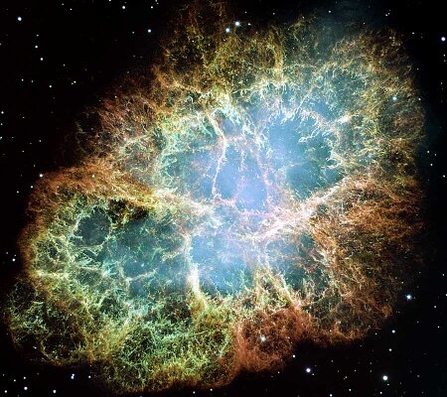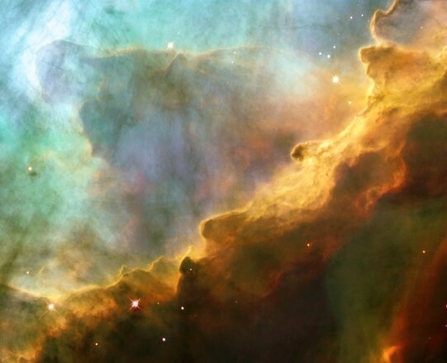 |
 |
 |
 |
 |
 |
 |
 |
|
 |
 |
 |
61 Supernova remnants
|
| Menu | back |
A supernova remnant (SNR) is an expanding cloud of dust and gas. An SNR should be perceivable for more than a million years before it disintegrates. However, the number of supernovae in our Milky Way is considerably lower than expected. The number of SNR agrees with the Milky Way, which is approximately 7,000 years old.
When a star with approximately twenty-five times the mass of our sun has burned a sufficient quantity of hydrogen to helium, it explodes. This temporary gigantic release of energy leads to an extraordinarily bright light within the course of a few days or weeks that can outshine all the other stars in the same galaxy. Such an event is called supernova.
A supernova can release the amount of energy that would normally be radiated by 1,000 suns over a period of eight million years (1). It leaves a gigantic cloud of gas, the supernova remnant (SNR), and a small central star. The SNR continues to expand following the explosion at a rate of over 7,000 km/sec and can reach a diameter of several light years in the course of time.
The SNR expansion process is described in three stages:
|
| 1. |
During the first 300 years, the SNR expands to a diameter of approximately twenty-three light years. The gaseous SNR then changes slowly into a liquid state.
|
| 2. |
During the next 120,000 years, the SNR should continue to expand to a diameter of approximately 350 light years. During this process, the now liquid droplets slowly form to a solid dust.
|
| 3. |
During the next six million years, the SNR would then thin out because of the expansion so that it finally could no longer be distinguished from its surrounding.
| |
Approximately every twenty-five years we can observe a supernova in our Milky Way. Depending on its position in the galaxy, the light from the SNR is weakened more or less by interstellar dust so that some of them are not visible any more.
Calculations and observations (1):
|
| First stage SNR: |
According to calculations, 19% of twelve first stage SNRs should be visible; two have been observed.
|
| Second stage SNR: |
According to calculations, 47% of 4,800 second stage SNRs should be visible. However, only 200 have been observed. This number we expect after approximately 7,000 years.
|
| Third stage SNR: |
According to calculations, 14% of 40,000 third stage SNRs should be visible. However, none whatsoever has been observed. This agrees with an age of the Milky Way of about 7,000 years.
| |
Crab Nebula:
|
 |
|
When the first photographs of the crab nebula were taken in the beginning of the twentieth century, it was noted that the nebula was expanding. Calculating back using this expansion rate, it was possible to conclude a supernova explosion 900 years ago. In fact, a supernova did occur in 1054, which was observed and is documented in thirteen independent historical sources (2).
|
Swan Nebula (Cygnus):
|
 |
|
Calculations performed some time ago indicated that the swan nebula is 100,000 years old. However, new data indicates that this figure should be reduced to fewer than 3,000 years. One of the variables on which the expansion rate of a nebula depends is the density of the interstellar medium. Near the swan nebula, this density is approximately ten times lower than the standard density in space. For this reason, new calculations revealed that the swan nebula has expanded to the size observed today in fewer than 3,000 years (3).
|
These 62 | Menu |
back
|
References:
|
| (1) |
Keith Davies, Distribution of Supernova Remnants in the Galaxy, Proceedings of the Third International Conference on Creationism, Pittsburgh 2, Penn., USA, 1994, page 177. |
| (2) |
Jonathan Sarfati, Exploding stars point to a young universe, Creation ex nihilo, Vol. 19, No. 3, June-August 1997, pages 4648. |
| (3) |
Keith Davies, The Cygnus Loop a case study, Journal of Creation, 20(3) 2006, pages 9294. | |
| |
Comment this Site!
|
 |
 |
 |
 |
|

